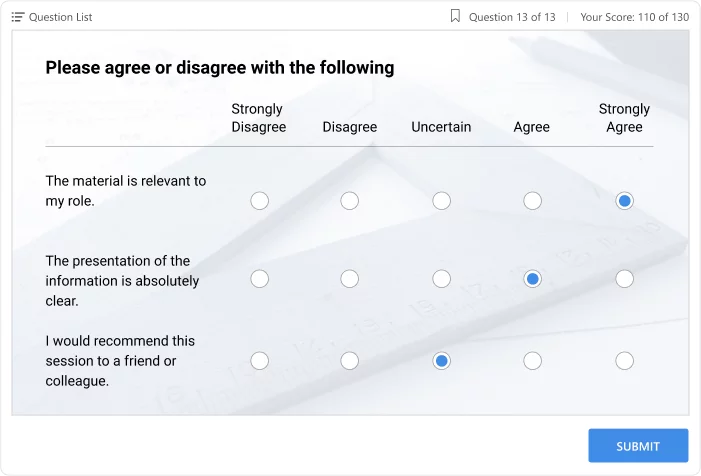Training Activities: Best Ideas and Examples for Engaging Your Employees

Every HR and L&D professional knows that even after doling out hundreds of thousands of dollars annually for professional training programs, any lecture or session that doesn’t leave much room for interactivity loses its punch. The desire to increase learning effectiveness motivates companies to care about employee engagement during L&D activities.
Whether you’d prefer instructor-led training or the eLearning format to achieve your learning objectives, in this article you’ll discover the most effective corporate training activities that will help you build a successful training program.
The Top 6 Instructor-Led Training Activities
Instructor-led training (ILT) is synchronous training in which an instructor, either in person or virtually (VILT), conducts a class. ILT happens in real time, allowing for immediate feedback and interaction between the instructor and learners.
However, this approach tends to be less flexible, as training sessions depend on the trainer’s schedule, venue availability (if conducted in person), and other factors. However, if bringing multiple employees together at the same time is not an issue for you, these corporate training activities are definitely worth considering:
1. Workshops
2. Debates
3. Games
4. Cross-training
5. Case studies
6. Webinars
1. Workshops
Workshops are hands-on meetings, as opposed to lectures or presentations that primarily consist of listening to a speaker. They are led by an instructor or facilitator as well, but encourage collaboration and teamwork, often requiring participants to break into small groups to solve problems, brainstorm ideas, and develop solutions. Such a format fosters a sense of community and mutual learning among the team members. Depending on the goal, such meetings can last a couple of hours or even a few days.
Workshop example
In a corporate setting, a workshop might focus on various themes. For example, a workshop on project management could involve a simulated project where attendees have to plan, execute, and then review their performance, providing valuable insights into how to manage real-world projects effectively.
2. Debates
Unlike workshops, where the emphasis is often on collaboration, debates fuel critical thinking through argumentation and counter-argumentation, and also boost presentation skills. Participants are divided into teams and presented with a topic or problem to argue for or against.
It’s becoming more common for good ideas to come from everyone in the organization, not just top management. Instead of just having a suggestion box, encouraging debates allows employees at all levels to brainstorm. During debates, the team might arrive at unexpected conclusions that can help make informed decisions on mission-critical projects.
Debate example
If the company is launching a new product, teams could debate various go-to-market strategies. This could include discussions on pricing plans, target audiences, and promotional tactics.
3. Games
Using training games in training isn’t just fun, it’s also a smart way to help employees learn and improve their skills. 83% of employees who undergo gamified training are more motivated at work. Because training games have rewards like scores, points, and even prizes, they positively reinforce learning behaviors that lead to better knowledge retention and overall training results.
Also read:
4. Cross-training
Cross-training or cross-departmental training is the practice of teaching employees the knowledge and expertise that are outside of their core work. Instead of specializing in just one job, employees learn how to perform various tasks, making them more versatile. Cross-training helps employees realize the other team members’ contribution to company goals and also ensures a seamless workflow when an employee takes a vacation.
Such training can be considered a form of ILT when it’s conducted under the guidance of an expert or instructor. However, it’s worth mentioning that cross-training can also be conducted through other methods, such as eLearning courses or on-the-job training, depending on the organization’s resources and needs.
Cross-training example
In the healthcare sector, a nurse might be cross-trained to perform administrative duties, enhancing the workflow during busy times or staff shortages. In manufacturing, a machine operator might be cross-trained to handle basic maintenance tasks for the equipment they operate. This ensures that minor issues can be promptly addressed without having to wait for a specialized maintenance team.
5. Case studies
People learn better through real-world cases than through theories. In case studies, employees are usually given information about a specific challenge or situation, collaborate with a team member, and come up with potential solutions.
Unlike debates that can be based on hypothetical challenges, case studies reflect real-world situations that employees have faced or may face, equipping them with the tools and confidence to handle similar situations in their day-to-day work.
Case study example
In the customer service sector, a case study might illustrate how an exceptionally difficult customer complaint was handled while maintaining the company’s reputation. In the financial industry, a case study on a failing investment strategy could be analyzed to identify errors and propose alternative approaches.
6. Webinars
Webinars, or web-based seminars, are led by an expert or a trainer who usually uses slides, audio, and sometimes video to guide the participants through a specific topic or set of skills.
Webinars are especially useful for training remote teams or when you need to share knowledge across multiple locations. They offer a level of convenience that traditional methods may lack, allowing people to participate from anywhere they have internet access, without the need for travel or physical meeting rooms.
Webinar example
Companies might host a webinar to communicate significant organizational updates, such as policy changes, new regulations, or a corporate rebranding initiative, to all employees.
The Top 7 eLearning Training Activities
Unlike instructor-led activities, which are often more rigid because of the need to coordinate with a trainer, eLearning puts the learner in the driver’s seat. The key distinction between synchronous ILT and asynchronous eLearning lies in the fact that employees can choose when and where to engage with the material. This autonomy is particularly appealing to adult learners, who often have diverse responsibilities and prefer having control over their learning paths.
Let’s cover some different eLearning activities that enhance employee engagement, such as:
1. Slide courses
2. Quizzes
3. Polling
4. Training videos
5. Role-play simulations
6. Mini-tutorials
1. Slide courses
Slide-based courses are the foundational format of eLearning activities. These are self-paced courses similar to PowerPoint slides but enriched with interactivities, clickable buttons, multimedia elements, and possibly narrations. This interactivity transforms passive viewing into an engaging experience.
Slide courses are great when you need to break down complex ideas into easily digestible chunks, allowing learners to focus on one concept at a time.
Slide course example
When creating slide-based courses, there are two pitfalls you’ll want to avoid. The first is building courses that feel like dull presentations, which won’t engage participants. The second is spending long weeks crafting quality content. Luckily, tools like iSpring Suite can help you overcome both of these challenges efficiently.
It’s a super easy course creation tool that works directly in PowerPoint and allows you to create attractive slide courses from scratch in a matter of minutes. See an example of the kind of course you can create with no initial design or coding skills:
2. Quizzes
Quizzes are a powerful and versatile tool in both the eLearning arsenal and during an in-person instructor-led training session. They can serve as a diagnostic tool to assess the initial level of employee knowledge and skills. Mid-course quizzes can help reinforce learning and keep the momentum going, while final assessments can provide a comprehensive review and measure overall knowledge retention.
Unlike ILTs, where it’s the instructor’s responsibility to mark assessments and assign grades, eLearning courses are often equipped with automated grading capabilities and feedback for correct and incorrect answers. Also, online quizzes offer trainees insight into employee progress and areas where additional training is needed.
Quiz example
iSpring Suite offers 14 types of quiz questions, including multiple-choice, super engaging drag-and-drop activities, hotspot, and sequence questions. Check out this demo of an interactive quiz you can create with iSpring Suite:
3. Polling
While quizzes are often used to evaluate understanding, polls serve to collect opinions and preferences or gauge the pulse of the group on various topics. This activity encourages participants to share their thoughts openly, leading to a more inclusive and collaborative learning environment.
You can start a course with a poll to understand what learners hope to get out of the training. During the course, intermittent polls can be used to get feedback on the pace, the difficulty of the material, or even to choose which topic to cover next. This not only gives learners a sense of control but also allows instructors to tailor the course in real time based on the responses.
Polling example
You can create this multiple-choice poll with iSpring in a couple of clicks:

4. Training videos
Training videos are effective eLearning tools that cater to diverse learning styles, provide a break from text-heavy materials, and allow you to explain complex concepts in a more digestible format.
This format gives employees the flexibility they need. Learners can watch pre-recorded video content whenever it fits into their schedule, making it easier to balance training with other responsibilities. They can also pause, rewind, or review the videos as often as needed, which supports better understanding.
Training video example
With iSpring Suite, you have plenty of opportunities to create training videos: whether they’re screencasts, video lectures, or even picture-in-picture videos that include your talking head footage and presentation slides. You can take a look at one of them here:
5. Role-play simulations
Role-play simulations bring the concept of learning by doing to a virtual environment, giving employees a chance to practice real-world scenarios. They can be held during face-to-face training and led by an instructor, but eLearning simulations allow learners to navigate different situations at their own pace and explore the consequences of their choices in a controlled manner.
In essence, it’s a safe-to-fail environment for trainees, especially those in sales and retail, to elevate their communication skills without jeopardizing a sale or your organization’s reputation.
Another benefit is repeatability. Employees can go through simulations as many times as they need to fully understand the material or improve their skills without any additional cost or organizational effort.
Role-play example
Role-play simulations might seem too complex to develop at first. But with the iSpring Suite drag-and-drop interface, you don’t need coding or other tech skills. Furthermore, the built-in Content Library offers thousands of pre-designed characters and locations to create an immersive training atmosphere. Characters can change their poses and facial expressions depending on the learner’s response.
See how it works in this role-play dialogue created with iSpring Suite:
6. Mini tutorials
Mini tutorials aren’t very conducive to ILT because they involve training that’s delivered in bite-sized and easy-to-digest pieces. As such, each learning module is laser-focused and therefore aims to address a single question, problem, or learning objective.
They can be built in several formats, such as a game, slide course, podcast, or video. With microlearning, it’s not so much the method of content delivery as it is content organization. If you’re looking to maximize knowledge retention in the least amount of time, then this training activity is a win-win situation for both you and your trainees.
Longread example
With an advanced subscription to iSpring Suite (called iSpring Suite Max), you can easily create mini tutorials with quizzes online, right in your browser. You only need to input text, images, and videos, as well as knowledge checks, if applicable. See how the mini tutorial might look:
Final Thoughts
All businesses understand that employee training and development are inextricably tied to their success. As such, spending the time, effort, and money to develop engaging corporate training activities will inevitably yield fruitful returns on your investment.
We hope these tips and examples will help you enrich your training program with new ideas. If instructor-led activities or face-to-face training are not always possible to conduct, why not opt for eLearning? Test-drive iSpring Suite during a free 14-day trial to create slide courses, record training videos, or build dynamic role-plays that your employees will love to engage in!















